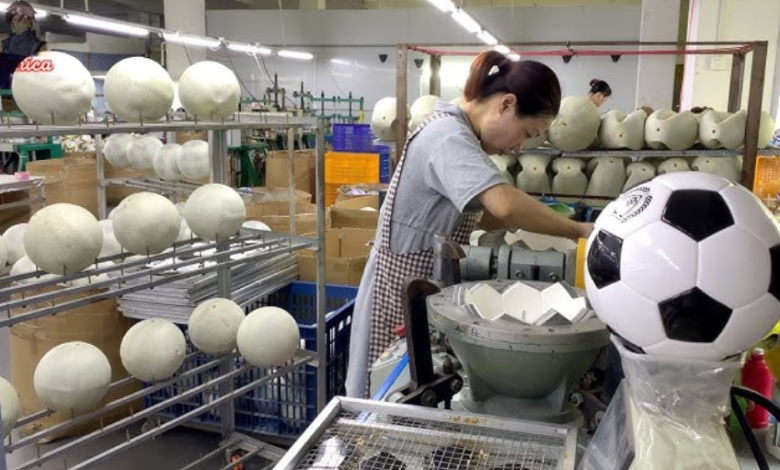The Role of a Sports Ball Factory in Modern Manufacturing

In today’s fast-evolving sports industry, the demand for high-quality equipment continues to grow. Among the essential components, sports balls hold a unique place as they directly influence gameplay and athlete performance. Behind every well-crafted football, basketball, or tennis ball is a sophisticated sports ball factory that ensures quality, innovation, and reliability.
Understanding The Importance Of Quality Manufacturing
The manufacturing of sports balls requires precision and attention to detail. Unlike many other products, sports balls must adhere to strict standards related to size, weight, bounce, and durability. A reputable sports ball factory ensures that these specifications are met, providing consistency for professional athletes and enthusiasts alike.
The process includes the careful selection of materials such as synthetic leather, rubber, or polyurethane, each impacting the ball’s feel and longevity. The factory’s role is not only to produce but to innovate, improving materials and techniques to meet the evolving demands of sports.
Materials And Technology Used In Sports Ball Production
Modern Sports ball factory employ advanced technology and materials to achieve superior products. The choice of materials varies according to the type of sport and intended use:
- Synthetic Leather: Used widely for footballs and basketballs, synthetic leather offers durability and grip comparable to natural leather but at a lower cost.
- Rubber Bladders: Provide the core structure for many balls, enabling air retention and bounce control.
- Polyurethane Coating: Enhances surface protection and water resistance.
Technological advancements, such as computerized stitching machines and laser cutting, allow sports ball factories to maintain high precision and speed in production. These innovations ensure uniformity across batches and reduce the margin of error that could affect performance.
The Production Process In A Sports Ball Factory
A sports ball factory follows a structured production process that includes multiple steps to guarantee quality:
Design And Prototyping
Before mass production, detailed designs and prototypes are developed. This phase involves selecting materials, finalizing dimensions, and testing initial models for performance metrics such as bounce, weight, and grip.
See also: Step Up Your Game: Choosing the Perfect Dance Shoes for Men
Material Preparation
Raw materials are inspected for quality and prepared for assembly. This includes cutting synthetic leather panels and molding rubber bladders.
Assembly And Stitching
Panels are stitched together with precision, often using automated stitching machines to ensure durability and uniform tension. In some cases, hand stitching is used for premium or professional-grade balls.
Inflation And Quality Testing
The ball is inflated to the required pressure and tested for bounce, roundness, weight, and balance. Defective balls are discarded or reworked to maintain the factory’s quality standards.
Packaging And Distribution
Finished products are packaged securely to avoid damage during transport and shipped to distributors, retailers, or directly to sports organizations.
Challenges Faced By Sports Ball Factories
Operating a sports ball factory comes with several challenges that manufacturers must overcome to stay competitive:
- Material Sourcing: Ensuring a steady supply of high-quality raw materials can be difficult due to market fluctuations and import restrictions.
- Cost Control: Balancing production costs while maintaining quality is essential, especially when competing in a global market.
- Environmental Concerns: Factories must adopt sustainable practices to reduce waste and carbon footprint, responding to increasing environmental regulations.
- Innovation Pressure: Keeping up with new technologies and evolving sports standards requires continuous investment in research and development.
Sustainability Practices In Sports Ball Manufacturing
Many sports ball factories are embracing sustainability to address environmental concerns. This includes:
- Using recyclable materials in ball production.
- Implementing energy-efficient machinery to reduce power consumption.
- Reducing water usage during manufacturing processes.
- Minimizing chemical waste through safer alternatives.
These measures not only help protect the environment but also appeal to eco-conscious consumers, creating a competitive advantage in the market.
The Future Of Sports Ball Factories
Looking ahead, the sports ball manufacturing industry is poised to integrate even more technology and sustainability. Innovations like smart balls embedded with sensors are gaining popularity, offering real-time data on player performance and ball dynamics.
Automation will further enhance production speed and accuracy, allowing factories to meet increasing demand without sacrificing quality. Additionally, sustainable materials such as biodegradable composites are expected to become mainstream, reflecting the global push for greener manufacturing.
Why Choosing The Right Sports Ball Factory Matters
For sports organizations, retailers, and distributors, partnering with a reliable sports ball factory is crucial. The right factory ensures that the products delivered meet professional standards and consumer expectations.
A trusted manufacturer provides consistent quality, timely delivery, and customization options to cater to specific sports and markets. This partnership can significantly influence brand reputation and customer satisfaction.
Conclusion
The role of a sports ball factory extends beyond mere production; it is a hub of innovation, quality control, and sustainability. As the sports industry grows and evolves, these factories must continue to adapt and improve to meet the complex needs of athletes and consumers worldwide.
By understanding the intricacies of sports ball manufacturing, stakeholders can make informed decisions that contribute to the success of their sporting ventures and promote the advancement of sports technology and sustainability.

